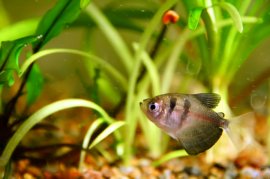![Beta fish: [link] [link]](http://www.vangbettas.com//img/blue_glow_by_bewitched_horror_on.jpg)
 Newly bought fish or sick fish are best observed and/or treated in a separate hospital tank instead of the main aquarium. Many medications and preventative supplements which are directly added to the water will affect the beneficial bacteria. This can bring the biological filtration to a grinding halt; it can use up oxygen and turn the aquarium into a ‘toxic dump’.
Newly bought fish or sick fish are best observed and/or treated in a separate hospital tank instead of the main aquarium. Many medications and preventative supplements which are directly added to the water will affect the beneficial bacteria. This can bring the biological filtration to a grinding halt; it can use up oxygen and turn the aquarium into a ‘toxic dump’.
In combination with a hospital tank fish dips and baths can be highly effective in preventing the spread of disease.
Fish dips and baths will remove external bacteria, parasites, and other disease causing organisms before introducing them into the main tank. Dips and baths are the next best thing to prophylactic quarantine. The main difference between the two is that the dip/bath is an external treatment, while a hospital tank allows the fish to be observed and treated for internal diseases and parasites as well.
The benefits of using a hospital tank can not be over emphazised. While all life is precious a hospital tank also doubles as a protective measure for your investment for higher priced setups such as reefs.
The difference between a bath and a dip is the time frame. Dips have a limited treatment duration which not to exceed, while a bath requires a prolonged treatment time.
Dips or baths should be administered for new arrivals or before transferring sick fish to a hospital tank, but are not necessarily recommended for treatments if the main tank is infected. Since a dip/bath stresses a fish it often weakens its immune system. If the main tank is still ‘sick’ this may cause the treated fish to contract the disease quicker then before once returned to the tank.
[title text=”Dipping Solutions”]
Freshwater Dip (for saltwater fish only)
The freshwater dip is probably the most common dip for saltwater species and will rid the fish’s body of many potential harmful parasites.
Parasites such as:
- Paravortex (the black spot disease a.k.a. black ick) which is caused by the turbellarian flatworm with a similar life cycle as “Ick”
- Cryptocaryon which is the marine equivalent to “ick” a.k.a. marine or saltwater “ick”
- Velvet or coral fish disease (similar life cycle as “Ick”) is difficult to diagnose due to a similar Ick-infested fish behavior, as well as the undetectable and highly infectious skin flukes (worms living on the fish).
Saltwater species have a constant exchange of fluids called osmosis, which in simple terms is when pure water dilutes the mineral and salt rich water in order to equalize. Freshwater will rupture the cells of the parasites instantly killing them in great numbers independently of the status of the reproductive cycle. (i.e. ick medications are only effective on the free-floating tomites).
The freshwater dip is very effective to rid the fish of parasites causing black ick, marine ick, velvet and flukes, but ineffective towards bacterial or fungal diseases.
The bath has to be prepared with pure water, preferably RO/DI, or as an alternative distilled water. The fish should be closely watched and the bath administered for 5-10 minutes.
Saltwater Dip (for freshwater fish only)
Fish stress is relieved and the organism can fight off diseases easier which aides in the recovery. The concentration should be 4 teaspoons per Gallon and the duration of the bath about 30 minutes. This bath will also stimulate the protective slime coat, which will further enhance the fish’s’ ability to cope with the disease.
Protozoa (one celled parasites) on skin, gills, and fins can effectively be removed by a salt bath. For the record, some fish do not respond well to a salt bath (i.e. some barbs, tetras, catfish and koi). A heavy concentration can make them loose their equilibrium and they simply “roll over”. At this point the fish has to be moved to clear water very quickly.
Formalin Bath
Formalin (formaldehyde gas dissolved in water) is used as a bath to rid external parasites. Formalin works by altering cell proteins.
Formalin is often used with Malachite Green, but should not be used in combination with any other medication. Extreme caution is necessary as Formalin depletes oxygen. The container used for the bath has to be continuously well oxygenated. Formalin will effect the biological filter and should never be introduced to the main aquarium.
The bath should consist of 250mg/l for about 60 minutes. Extremely sick or weak fish should be removed after 30 minutes. In warmer water (above 70F/21 C) 150 mg/L should be used for no longer then 60 minutes.
Malachite Green
This compound rids the fish of all fungal infections. Malachite green is a respiratory poison and damages the cell metabolism. Rarely used by itself, the bath should contain 1-2 mg/l for 10 minutes, or 0.5 mg/l for up to 1 hour.
Malachite Green will turn colorless at higher pH levels, but that does not mean that it lost its potency.
Light will deactivate this compound either if used by itself or in combination with other medications, light should therefore be kept at a minimum.
Formalin and Malachite Green
Both compounds are often used in combination because both increase the benefits of each other. They are also less toxic as if used separately.









